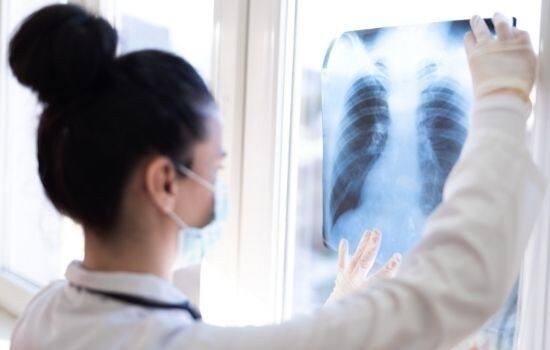Attention GCI Patients — Effective October 6, 2025, the GCI Oak Lawn location will be closed. All patients of GCI Oak Lawn will be seen at our Chicago Ridge location at 10604 Southwest Highway, Suite 109, Chicago Ridge, IL 60415.
August 30, 2021
Should I Be Screened for Lung Cancer?

Cancer screening is one of the most important things we can all do for ourselves. By finding cancer early, it’s easier to treat. This means people are living longer than ever after a cancer diagnosis!
Lung cancer doesn’t typically show symptoms until it’s relatively advanced and harder to treat. But screening for lung cancer wasn’t an option until recently. How is the test performed and who is eligible for lung cancer screening?
What is the Lung Cancer Screening Test?
The lung cancer screening test was developed because diagnosing lung cancer using X-ray and sputum cytology – were not effective in reducing the number of lung cancer deaths. The test itself is a low-dose CT scan recommended by the United States Preventive Services Task Force in 2013.
In 2021, they lowered the recommended screening age to 50 and lowered the number of "pack-years" of smoking history. In making these changes, they expanded screening to almost seven million more Americans, including more high-risk women and racial minorities. In the United States, more than 8 million people qualify as high risk for lung cancer and are eligible for lung cancer screening tests.
Research shows that lung cancer screening reduces the death rate by 10-14% among high-risk populations.
Who Is a Candidate for Lung Cancer Screening?
It's important to discuss lung cancer screening with your doctor at regular doctor visits. You need to fully understand the specific risks and benefits for your health before deciding to have or not have screenings.
The standards for who should be screened for lung cancer are very specific and based on age and smoking history. Annual lung cancer screenings are recommended for people who are:
Between the ages of 50 to 80, AND
You are a current smoker or have quit smoking within the past 15 years, OR
Smoked one pack or more of cigarettes per day for 20 years or more, or two packs a day for ten years or more
Screening can be stopped when the patient:
Turns 81 years old
Has not smoked in 15 years
Develops a serious health problem that makes them a poor candidate for surgery if lung cancer is found
Is not willing to undergo lung cancer surgery
Most insurance plans will cover the cost of lung cancer screenings for patients who meet specific criteria. Additionally, Medicare will cover these screenings, but you must meet the qualifications listed above.
What to Expect During a Lung Cancer Screening
A low-dose computed tomography (low-dose CT) scan only takes a few minutes and is not invasive or painful. You lie on the X-ray machine table while it takes detailed pictures of your lungs. The machine scans your body in a spiral path to provide maximum details. Very low amounts of radiation are used.
Benefits of Lung Cancer Screenings
The chief benefit of lung cancer screening is living longer. Detecting lung cancer earlier means that treatments can begin sooner. This results in the best chance of a cure. Lung cancer screening has reduced deaths from lung cancer by between 12,000 and 20,000 people a year.
The benefits of screening are greater as your risk for lung cancer increases. By catching it earlier, fewer treatments may be necessary. For example, surgery to remove the cancerous part of the lung can cure early-stage lung cancer in many cases.
Risks of Lung Cancer Screenings
While lung cancer screenings are helpful, there are also some risks to keep in mind. The risks include:
Getting a false-positive result. This means you do not have lung cancer, but the screening test was wrong and indicates you do have lung cancer. No test is 100% accurate, and sometimes the screening produces an incorrect result. This can be a risk because it may lead to follow-up tests, biopsies, or surgeries that you don't need. For example, a biopsy to diagnose lung cancer can cause part of the lung to collapse. Surgery is sometimes needed to reinflate the lung, and surgery always includes additional risks. Risks from LDCT screening are higher in heavy smokers and long-time smokers.
Getting a false-negative result. If you have cancer, but the result says you do not, you won't get treatment. If you are being screened every year, you may not get an accurate result for another year. If you notice any symptoms of lung cancer between screenings be sure to schedule an appointment with your physician.
Overdiagnosis means nodules, masses, or nonaggressive cancer is found, but it won't cause symptoms or any health problems. You may undergo continued monitoring and additional diagnostic testing. This can cause undue worry while you wait six months to one year for a repeat LDCT scan. Research tells us this happens in 10% to 20% of people who are screened.
Repeated Screenings can cause cancer from repeated exposure to the radiation required to perform the test. In most cases the benefits of screening outweigh the risk of developing cancer from the screening test itself. However, you should work closely with your doctor to ensure you receive low-dose CT screenings only when necessary.
Next Steps for Lung Cancer Screening
Talk to your primary care doctor about your lung cancer risk level and if you are a good candidate for lung cancer screening. Remember, screening does not diagnose cancer. If something is found you will see a medical oncologist who will run diagnostic tests to provide an accurate diagnosis, identifying the specific type of lung cancer and stage.
The lung cancer specialists of Affiliated Oncologists are located throughout the Southland in the Chicago area to provide the latest in lung cancer treatments. Request an appointment if you or a loved one has received a lung cancer diagnosis.
Categories: Lung Cancer